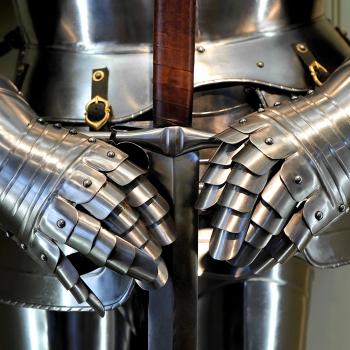To Train Up A Child, chapter 6
We have now arrived at chapter 6, “Applying the Rod.” It’s a short chapter, so we’re going to cover the whole thing today. Michael touches on abuse in this section, i.e. actually (he thinks) addresses it, so get ready!
TO DO MY DUTY
When the time comes to apply the rod, take a deep breath, relax, and pray, “Lord, make this a valuable learning session. Cleanse my child of ill-temper and rebellion. May I properly represent your cause in this matter.” No jerking around. No raised voice. The child should be able to anticipate the coming rod by your utterly calm and controlled spirit.
At this point, in utter panic, he will rush to demonstrate obedience. Never reward delayed obedience by reversing the sentence. And, unless all else fails, don’t drag him to the place of cleansing. Part of his training is to come submissively. However, if you are just beginning to institute training on an already rebellious child, who runs from discipline and is too incoherent to listen, then use whatever force is necessary to bring him to bay. If you have to sit on him to spank him then do not hesitate. And hold him there until he is surrendered. Prove that you are bigger, tougher, more patiently enduring and are unmoved by his wailing. Defeat him totally. Accept no conditions for surrender. No compromise. You are to rule over him as a benevolent sovereign. Your word is final.
Otherwise, tell him to bend over on the bed or couch; and while he is in this position give some choice admonition. You have his undivided attention. Slowly begin to spank. If you go too fast, you may not allow time enough for the inner transformation to occur.
Use your own judgment as to what is effective. I found five to ten licks usually sufficient. Sometimes, with older children, usually when the licks are not forceful enough, the child may still be rebellious. If this occurs, take time to instruct and then continue the spanking. A general rule is to continue the disciplinary action until the child is surrendered. A spanking is made effective, not by its severity, but by its certainty. Spankings don’t have to be as hard where they are consistently applied. Your calm dignity will set the stage to make it more effective.
If an older child perceives a self-defensive, competitive posture in the parent, he will react to the spanking much as he would if whipped by an older, bigger boy down the road. He will become subdued and cautious but not honoring. It will control his actions but not change his attitude.
If you were reading last week, you will note that my parents applied Michael’s instructions of how to “apply the rod” to the letter. In his last paragraph Michael nears the truth—he realizes that a parent’s actions in applying the rod may be perceived by the child as bullying. So close, and yet so far—Michael insists that if the parent maintains the correct attitude, calm and dignified, her actions will not be perceived as bullying. This isn’t true. Last week I described what went on inside of me when I was spanked a la Pearl as a child. My narrative is at the end of that post, in italics. It’s worth reading, if only to contrast with what Michael wrote above.
INSTRUMENTS OF LOVE
Make it a point never to use your hand for spanking. Exceptions should be highly justified. It is usually the impatient, personally offended parent whose hand continually darts out like a snake. The parent, too busy to take the time needed for training, blurts out, “Just get off my back, leave me alone, stop bothering me.” The hand swatting is a release of the parent’s own frustration.
Furthermore, where the child is concerned, the hand is for loving, not martial arts. The hand on a diapered bottom is useless as a spanking, but effective in causing permanent damage to the spine. There is no surface pain to the child thus whipped. Any pain would be deep inside, similar to a fall or a car wreck. Any spanking, to effectively reinforce instruction, must cause pain, but the most pain is on the surface of bare skin where the nerves are located. A surface sting will cause sufficient pain, with no injury or bruising. Select your instrument according to the child’s size. For the under one year old, a little, ten- to twelve-inch long, willowy branch (striped of any knots that might break the skin) about one-eighth inch diameter is sufficient. Sometimes alternatives have to be sought. A one-foot ruler, or its equivalent in a paddle, is a sufficient alternative. For the larger child, a belt or larger tree branch is effective.
Michael is very detailed in his discussion of causing children pain. He argues that parents must cause their children pain when “whipping” them, but that parents must ensure that they cause maximum pain and minimum physical harm. In some sense this is a way to get around child abuse laws, which generally focus on physical harm and not the level of pain caused. Notice that Michael endorses whipping one-year-old children with a switch and beating “larger” children with a belt, or a tree branch. When he wrote his book, Michael must have not yet discovered that plumbing supply line could be used to whip children, which he endorses on his website today and praised up and down in an interview with Anderson Cooper in 2011.
But of course, Michael is wrong. If you apply a switch for long enough, you cause the child’s muscle tissue to break down, which then leads to muscle failure and eventually death. This is what happened to Lydia Schatz. Lydia’s parents used the plumbing supply line suggested by Michael, and applied it exactly as he described earlier in this passage, and Lydia died. It seems that things like switches, paddles, tree branches, belts, and plumbing supply line do more than just cause pain.
Interestingly, I’ve spoken with quite a few people who think spanking that consists of a quick swat with the hand is acceptable while spanking that involves hitting children with objects is abusive. This surprised me when I first heard it, because I grew up on Michael’s teaching that spanking with a hand, the instrument of love, is wrong, while beating a child with an object, such as a switch or paddle, is mandatory.
A CAUTION TO RECIPIENTS OF THE MILLSTONE AWARD
There are always some who act in the extreme. Such could use what has been said about the legitimate use of the rod to justify ongoing brutality to their children. I can think of several right now. These abusers of their children would not in the least view themselves as such. They would call themselves “strong disciplinarians.” “But whoso shall offend one of these little ones which believe in me, it were better for him that a millstone were hanged about his neck and that he were drowned in the depth of the sea (Matt. 18:6).”
That Michael would quote this verse so soon after advising parents to sit on children and beat them until they have “surrendered” and are defeated “totally” would be viewed by most as highly ironic.
Okay, so here is the real question: What exactly constitutes abuse, according to Michael? Where is the line? He speaks against “ongoing brutality” but has just endorsed beating larger children with belts and switching babies. It is all well and fine to say you oppose abuse, but when you don’t tell parents where that line is, and when you yourself endorse things that are quite obviously abuse, your words ring very hollow indeed.
FORMS OF ABUSE
Only a few parents are categorically abusive. But, many parents sometimes give in to an abusive manner or employ abusive methods. The child is rebellious. The parent suddenly loses it and screams out. Like a whirlwind, the child is snatched up by the arm and given several bangs on the bottom. The parent’s eyes burn. The brow hardens. The pulse rate soars. Anger is the best word to describe the feelings. Smash! Subdue! “You will do what I say. You are not going to do this to me little girl.” Red faced, muscles tensed. Anyone looking on the face of the parent would think there was a war on.
The rod should not be a vent for the parent’s anger. In the daily run of life, many people generally experience anger and feel the need to strike out. There is no place for that selfish vindictive streak in the discipline of children. Where the child’s good is not the supreme motivation, there will be problems.
I am ashamed to say that, in most cases, the rod is administered at the end of an intolerance curve. The average parents (Average parents end up with average children—the wrong end of the scale) are quite predictable in their “discipline” reactions. They go through several “warm-up” exercises to become sufficiently angry to generate retaliation against the child.
Here Michael continues an earlier theme: It is only corporal punishment administered in anger that is abuse. Corporal punishment administered calmly and without emotion is not abuse. It is anger that leads to abuse, not actual corporal punishment. But of course, this is wrong, incredibly wrong. I’ve read some interesting discussions of what is worse, being beaten by an angry parent or being beaten by a calm parent. I can’t really judge, as my parents never spanked me in anger, and to be perfectly honest being spanked by an angry parent sounds worse. But I have friends whose parents did hit them in anger who have told me they preferred it to being hit in unnatural calm because at least it was predictable and understandable. Regardless, sitting on children and hitting them until they have “surrendered” and are defeated “totally” is wrong, horribly wrong, whether or not it meets a state’s legal definition of abuse.
COMMON SCENARIO
“Johnny, stop climbing on the stool. You could break something. Did you hear what I said? I am not going to tell you again. What do you mean, ‘No?’ Now you do what I tell you to—right now. DO YOU HEAR ME?!! GEEETT DOWNNN!!! I have had about all I am going to take from you. Why are you always so hard headed? You are driving me crazy! This is absolutely the last time I am going to tell you…
“GET DOWN!!!” Then she tell him several more times.
At this point it is a competition between the emotionally disturbed mother and the little boy. A cauldron of anger and resentment has built up in this mother that is momentarily at a near killing rage. It is the exact feelings that, in greater proportions, and in the less restrained, lead to murder dozens of times every day. Her hostility gushes forth. Like a striking snake her arm becomes a bungle cord yanking the child from the stool, swinging him screaming through the air. With the other bare hand she strikes out at his bottom in a wild spray of flat handed karate chops. The gyrating child, his little shoulder nearly dislocated, screams his protest of defiance. The mother has vented her anger and is ready to resume her routine. The child goes off to plot his next escapade. This has no more resemblance to discipline than a playground fight.
Once the parent’s feelings of personal injury are expelled through this act of violence (that’s what it is in the case described) and the kid flees from sight, or appears sufficiently subdued not to cause the parent more trouble, the parent is satisfied. “Forget the kid. He will not cause ME any more trouble for awhile.” A truly concerned parent is going to patiently instruct the child for his own good. The rod must be accompanied by reproof in order to give wisdom. By reproof, we don’t mean ranting and raving.
It is this very knowledge of their own lack of self-control that constrains some parents from ever using the rod. Their own life is so out of control and filled with guilt that they recognize their inability to be objective and fair in discipline. Their unwillingness to repent and bring their own life into balance will cause the children to suffer from a lack of the proper administration of the rod.
One of the marks of the unbalanced use of the rod is the lack of accompanying instruction. “The rod and reproof give wisdom (Prov. 29:15).” Where there is just a venting of the parent’s anger, there will be no careful, patient, concerned reproof. The rod should be viewed as an aid to instruction, in that it reinforces reproof, not as the last resort of a frustrated superior force. Reproof without the rod is equally unbalanced.
Michael describes the parent’s actions in this scenario as “violence,” and yet refuses to recognize that he also teaches parents to exercise violence against their children. Here is a quote from earlier in this very passage:
If you are just beginning to institute training on an already rebellious child, who runs from discipline and is too incoherent to listen, then use whatever force is necessary to bring him to bay. If you have to sit on him to spank him then do not hesitate. And hold him there until he is surrendered. Prove that you are bigger, tougher, more patiently enduring and are unmoved by his wailing. Defeat him totally. Accept no conditions for surrender. No compromise.
How is this not “violence”? It very obviously is.
Throughout his book, Michael sets up examples of parents at their whits’ end losing control in order to contrast his own methods and paint them as benevolent and kind. But as I’ve noted before, he appears to be unaware that there are other alternatives. Yes, there are parents who lose control as Michael describes above. That is wrong. But parents who follow Michael’s teaching and calmly and dispassionately beat a child into absolute and unquestioning obedience? That is also wrong, very very wrong, and perhaps more wrong in that it is so premeditated and intentional.
But what about ditching corporal punishment altogether? What about moving away from a punitive focus and instead communicating with your child, bonding with your child, and lovingly guiding your child? It’s almost as though Michael is unaware of things like positive parenting and gentle discipline, as he never actually addresses it. He only sets up as contrasts permissive parenting and whits’ end parenting, etc. I’m unsure whether Michael is actually unaware of good parenting or whether Michael is leaving it out of his book so as to most effectively sell his brutal, abusive parenting.
I’m glad I do more than take down Michael’s book here on the blog. I also blog about my own adventures in positive parenting, and have received many comments and emails from parents and non-parents thanking me for my writing. I’d like to think that I help offer a positive alternative.














